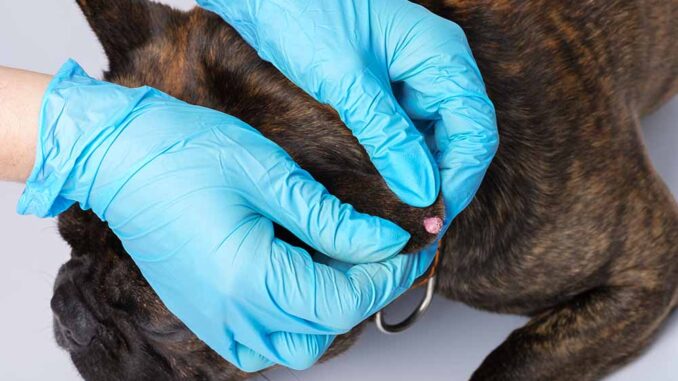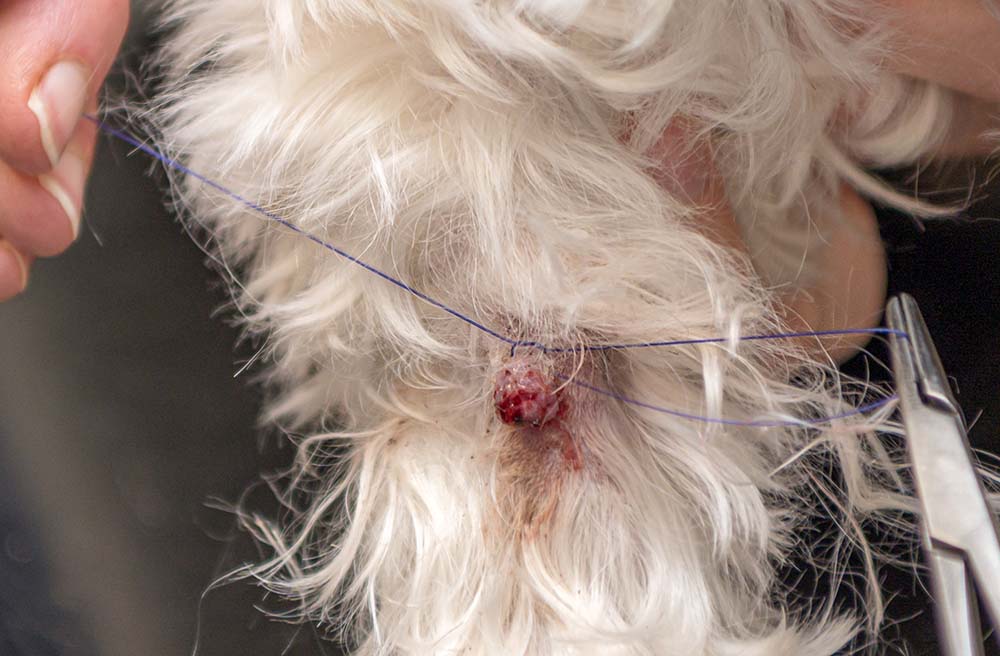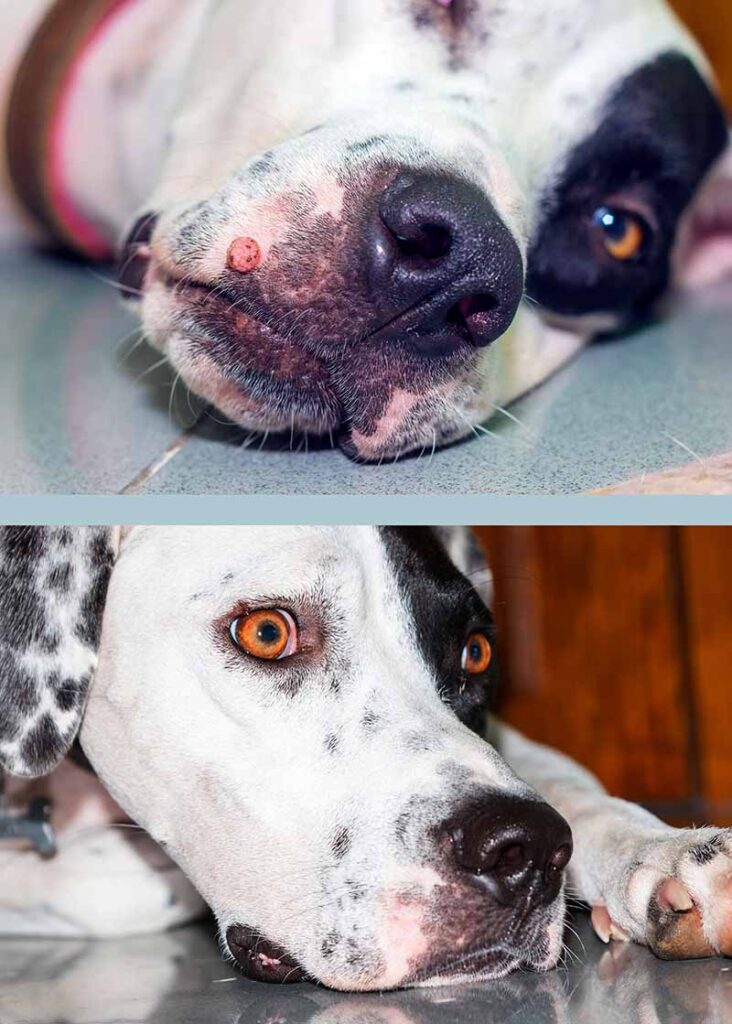
This article was updated on March 12th, 2024

Warts are usually nothing to worry about. However, they will bother some dogs who will want to chew and lick these growths, causing them to become inflamed and bleed. If this happens, you may indeed want to consider removing them.
A veterinarian needs to perform the removal procedure. Here is why:
- Dog warts can bleed a lot.
- Removing a wart at home will likely create an open wound that is susceptible to infection.
- It will be painful for your dog.
When Should You Remove Warts?
Many times, you do not need to remove them: my own dog Ruby has about 10 to 15 warts on her. She has not bothered any of them, so we have not removed them. Dog warts are usually benign, meaning that they are not cancerous growths and usually do not need to remove them.
Some dogs will want to lick, chew, or scratch at the wart on their body. This can cause them to bleed. The only way to stop your dog from bothering these warts is often to have them surgically removed by your vet.
“It is imperative to have a veterinarian confirm that the mass is, in fact, only a benign wart: cancerous lumps and warts can sometimes look similar.”
Three Effective Ways to Remove Dog Warts
There are a few main ways to perform the procedure, including:
1. Using a scalpel to cut it off.
This method involves your vet using a scalpel blade and cutting it off, then putting a few stitches to close the skin. General anesthesia or a local pain block is required.

2. Using Electrocautery.
An electrocautery unit will cut and cauterize the wart at the same time. This makes removing the mass very quick. If the growth is very small, your dog may not even need any stitches. A local pain block is most commonly used for single warts.

3. Using Cryotherapy and freezing it off.
This is what is commonly done with people. Using cryotherapy to freeze the mass and letting it eventually fall off.
The method will be determined by your vet based on the location of the wart, what equipment is available, and their preferred method for removing the wart.
Cost can range from $200 to $700 depending on the number of bumps to remove
The cost of these procedures will range from $200 to $700+ depending on where you live and how many warts need to be removed from your dog. Many people will ask their vets to remove their dogs’ warts when the dogs are sedated for a different procedure, such as dental cleaning. This helps reduce the number of surgeries and is less expensive: it may add only an extra $100-$150 on top of another procedure that your dog might need anyway.
What you should NOT do: DIY methods
In the picture below, a person attempts to remove a wart on a dog with a thread. They attempted to tie a string around the dog’s wart when it was dangling. However, many warts are flat, and it is hard to tie a string around them. Also, you will not remove the base cells of the wart that are within the skin layer, and it will just grow back. This is NOT an effective method.
Additionally, this is an old and cruel, painful process for your dog – a bad idea all around.
In the picture below, the area is not shaved, prepped, or sterilely scrubbed. This could lead to an infection.

Can you Remove a Wart at Home? (Without Your Vet’s Help)
No, attempting to remove it without pain control is cruel and should not be attempted. There are also a lot of risks to your dog other than pain, such as infection, bleeding, and recurrence.
Before and after pictures
The two pictures below show a big wart on the muzzle of a dog before and after treatment:

What are Alternatives to Surgically Removing a Dog Wart?
Many times you may not want to put your dog through surgery to remove a wart. Once your vet has indeed confirmed it is a benign wart (and not a cancerous lump), you can just watch it and monitor it at home. As long as it does not grow and your dog is not bothering the wart, it can stay on your dog. Make sure to take your dog to the vet to ensure it is a wart to avoid missing a dangerous cancer.
Can You Use Natural Methods with Apple Cider Vinegar? Do These Methods Really Work?
No, they do not help. If the wart falls off, it is because it was going to just go away on its own. Apple cider did not do anything to cause it to fall off.
How to Recognize Warts from Skin Tags or Other Lumps
At first glance, dog warts and skin tags may appear the same: small, flesh-colored lumps on your dog’s skin can be hard to differentiate; however, there are a few differences that will help clue you in and identify dog warts.
- Warts may be darker or lighter than the surrounding skin, and lumpy like a head of cauliflower. Skin tags tend to blend in. Skin tags are flesh-colored and small.
- Warts are rounder, with a thicker base close to the skin. Skin tags will be more tear-shaped and hang from a stalk. They usually dangle away from the body on a stalk that is smaller around than the lump.
- Warts can be anywhere, but since they come from a contagious virus, they’re more likely to show up on the face and feet, where they come in contact with other dogs. Skin tags congregate in areas of friction or irritation, so between the legs and body, on the chest and the lower legs.
Your vet will be able to definitely confirm the correct diagnosis by taking a small sample and looking at it under the microscope. Learn more in our article: is it a wart or a skin tag?
FAQ
Are there locations that make it tricky/risky to remove a dog wart? (near eyes, nose, etc.)
Warts that are located on the paws and legs are harder to remove since there is not as much skin left to close the incision. Warts on the face can be risky since there are other structures, such as the eyes, that you have to avoid.
Are there any side effects?
There are usually no side effects of having warts growing on your dog. However, they can bother the dog and then get infected when they lick them.
Can dog warts just go away on their own? In which case does this happen, and how do I know?
Some can fall off. These are usually small warts that are not very attached to your dog’s skin. It can take many months, but some will just slowly go away on their own.
Final Thoughts
If your dog has warts on their body, you may be tempted to try to remove these yourself. It is best for you to just leave the removal process to your vet. They have everything that is needed to help prevent bleeding, infection, and pain.
Many times, you can leave these growths alone and they will be just fine. Many dogs live with multiple warts on their body without any side effects.
Disclaimer: This website's content is not a substitute for veterinary care. Always consult with your veterinarian for healthcare decisions. Read More.


Be the first to comment